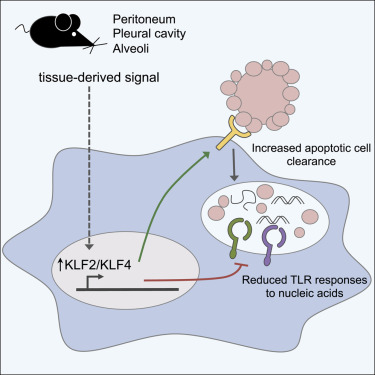Immunity ( IF 25.5 ) Pub Date : 2017-11-14 , DOI: 10.1016/j.immuni.2017.10.006 Allison W. Roberts , Bettina L. Lee , Jacques Deguine , Shinu John , Mark J. Shlomchik , Gregory M. Barton

|
Although apoptotic cells (ACs) contain nucleic acids that can be recognized by Toll-like receptors (TLRs), engulfment of ACs does not initiate inflammation in healthy organisms. Here we identified macrophage populations that continually engulf ACs in distinct tissues and found that these macrophages share characteristics compatible with immunologically silent clearance of ACs; such characteristics include high expression of AC recognition receptors, low expression of TLR9, and reduced TLR responsiveness to nucleic acids. Removal of the macrophages from tissues resulted in loss of many of these characteristics and the ability to generate inflammatory responses to AC-derived nucleic acids, suggesting that cues from the tissue microenvironment program macrophages for silent AC clearance. The transcription factors KLF2 and KLF4 control the expression of many genes within this AC clearance program. The coordinated expression of AC receptors with genes that limit responses to nucleic acids might ensure maintenance of homeostasis and thus represent a central feature of tissue macrophages.
中文翻译:

驻留在组织中的巨噬细胞被编程为沉默清除凋亡细胞。
尽管凋亡细胞(AC)包含可以被Toll样受体(TLR)识别的核酸,但是AC的吞噬并不会引发健康生物体中的炎症。在这里,我们确定了连续吞噬不同组织中AC的巨噬细胞群,并发现这些巨噬细胞具有与AC的免疫沉默清除兼容的特征。这些特征包括AC识别受体的高表达,TLR9的低表达和TLR对核酸的响应降低。从组织中去除巨噬细胞导致许多这些特征的丧失以及产生对AC来源的核酸的炎症反应的能力,这表明来自组织微环境的提示将巨噬细胞编程为沉默的AC清除。转录因子KLF2和KLF4控制该AC清除程序中许多基因的表达。AC受体与限制对核酸反应的基因的协同表达可确保维持体内稳态,因此代表了组织巨噬细胞的主要特征。











































 京公网安备 11010802027423号
京公网安备 11010802027423号